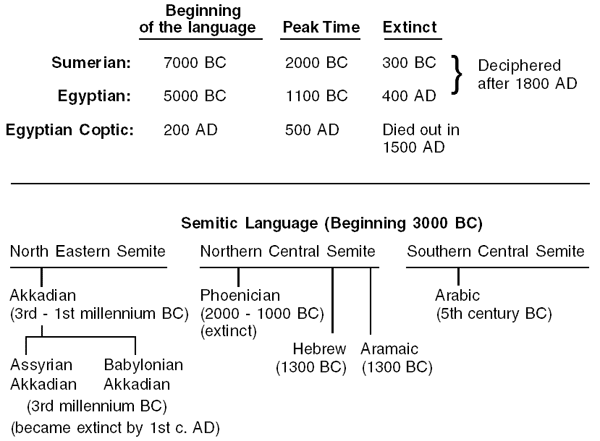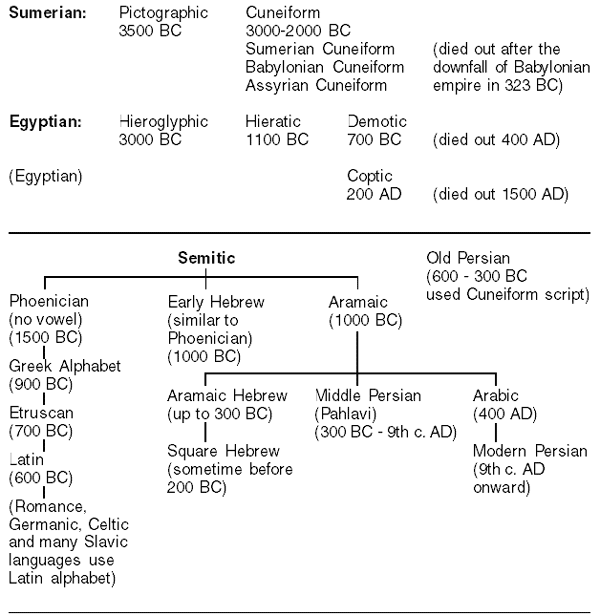 |
(29) The eternal perfection
of the Sanskrit language which
is the mother language of the world.
Diagram 3 (Languages of the world.)
Diagram 4 (Writing systems of the world.)
Comparative view of Sanskrit and other languages of the world
Languages of the world
Sanskrit language.
How it became the origin of other languages of the
world
DIAGRAM 3.
Languages of the world.
The earliest known Sumerian
and Egyptian languages are extinct. The Semitic, European
Family of languages (see Diagram 2), and Sino-Tibetan group of
languages of Eastern Asia (that also include Chinese languages) cover the
languages of almost the whole world of today, although quite a number of
languages of these three main groups have also died out long ago.

DIAGRAM 4.
Writing systems of the world.
The writing systems of the world
developed in a very primitive style. First they were in a pictographic
shape, then changed to a somewhat cursive form but with no vowels. Then,
after a long time, it took the shape of a proper alphabet with vowels. In
the beginning there were very few words to start with. The morphology
gradually improved and the vocabulary expanded. The writing system of
Sumerians and Egyptians died out, Chinese and Semitic
survived which became the prototypes for the development of the writing
systems of Eastern Asia and the rest of the world of today.
However, in all the alphabets of the languages of
the world the basic characteristics of their vowel system resembles the
vowels of the Sanskrit language along with some of the consonants
also.

Note: The Chinese writing system of
earlier times originated the development of other East Asian writing
systems. It has no alphabetical system of writing. Chinese characters are still in logographic shape.
A comparative view of Sanskrit and other languages of the world.
Diagram 1 tells the prolonged history of the slow and
gradual development of the Greek and Latin languages which Jones tried to
compare with the all-perfect Sanskrit language. The diagrams 1, 2, 3 and 4
give a complete picture of the incompleteness and the inconsistency of the
alphabets, words and the linguistic development of all the languages of
the world.
Languages of the world.
You can see that these languages never even had their
own alphabet. The Iranian language, Persian, borrowed its alphabet three
times from three different sources (cuneiform, to Aramaic, to Arabic)
within 1,300 years and in its advanced stage it has only three (a, i, u)
vowel marks which are used for both long and short sounds. They are
totally inadequate to give the correct pronunciation of the words. So,
unless you know the words, you cannot pronounce them correctly. The Greek
language started from incomplete consonants which was borrowed from
Northern (Phoenician) Semites, then added some vowels, improved the shape
of the letters, added more long and short vowels, and thus, improved the
language by constantly changing, altering, adding and modifying the word
morphology, their inflection and the syntax as well. It also improved its
vocabulary by borrowing the words from other languages, and thus, bringing
it to the level of its modern standard where still a number of grammatical
imperfections exist. Similar is the history of all the languages of the
world. Latin and English languages also went through a number of changes
before even their vocabulary was standardized from Germanic tribal
language, which adopted Latin alphabet and then modified it.
Sanskrit language.
How it became the origin of the languages of the
world.
Sanskrit language, as we see is all-perfect from the
very beginning when the western world didnít even have a proper alphabet.
The words of the Vedas like: vishanti, upasate

are used in the same way in the
Gita and the Puranas because there has never been any change or
improvement in the formation of its words as it was the self-perfected
language, which is also an indication of its Divineness.

The Manu Smriti says that the ambitious chatriyas
of Bharatvarsh went abroad to the neighboring countries to establish their
new kingdoms and, as they were cut off from the mainstream of the Bhartiya
civilization and culture, they developed their own language and
civilization as time went on and, forgetting Bhartiya culture, they became
totally materialistic. This happened millions of years ago even before the
last ice age. Natural calamities totally shattered their civilizations but
still the survivors, in the spoken form of their primitive languages, held
many apbhransh words of the original Bhartiya Sanskrit language
which their remote ancestors had retained in their memory. Again (after
the last ice age receded), when they started to re-establish themselves,
according to their existing memory and with the scanty literal and
cultural information that they received before the Christian centuries
through the trade connections with India, they developed their own culture
and religion. In this way, (a) a very remote connection of the people of
the entire world with Bhartiya culture and language (Sanskrit), and (b)
the later connections of the people of the world with Bharatvarsh and its
Sanskrit language is established. Such an affiliation of Bhartiya culture
and the Sanskrit language was indirectly integrated into the growth of
their literary development, thatís how the apbhranshas were found
in all the languages of the world (especially in the European group of
languages). This situation itself is the authentication of this fact that
Sanskrit is the first and the mother language of the world; and its unique
and eternal perfection, which is unimagined and unmatched in the world, is
the positive verdict of its being a Divine (supernatural) language.

|
 |
 |